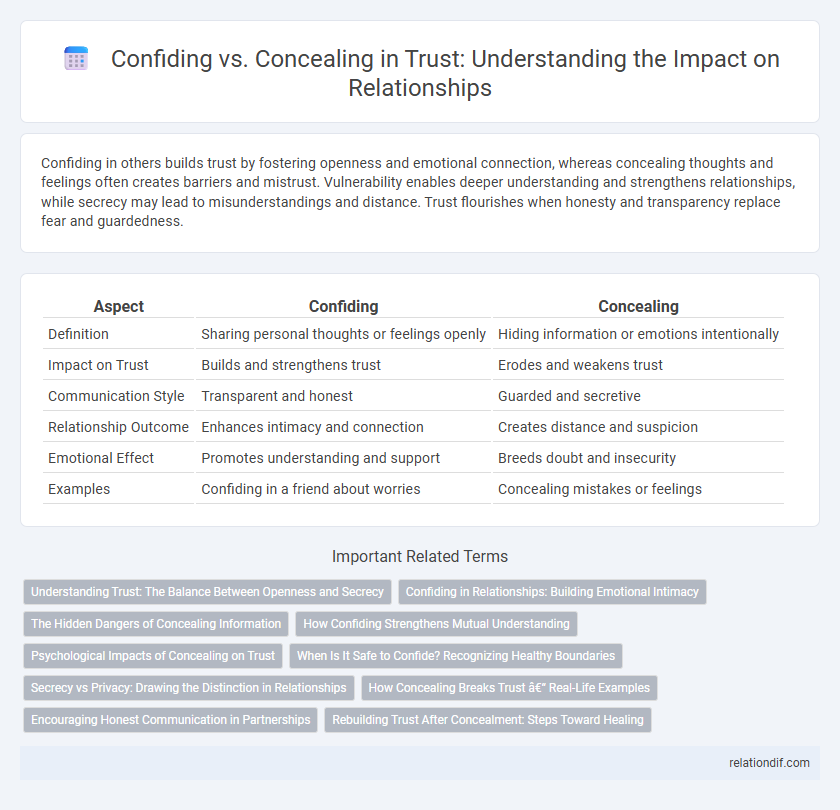Confiding in others builds trust by fostering openness and emotional connection, whereas concealing thoughts and feelings often creates barriers and mistrust. Vulnerability enables deeper understanding and strengthens relationships, while secrecy may lead to misunderstandings and distance. Trust flourishes when honesty and transparency replace fear and guardedness.
Table of Comparison
| Aspect | Confiding | Concealing |
|---|---|---|
| Definition | Sharing personal thoughts or feelings openly | Hiding information or emotions intentionally |
| Impact on Trust | Builds and strengthens trust | Erodes and weakens trust |
| Communication Style | Transparent and honest | Guarded and secretive |
| Relationship Outcome | Enhances intimacy and connection | Creates distance and suspicion |
| Emotional Effect | Promotes understanding and support | Breeds doubt and insecurity |
| Examples | Confiding in a friend about worries | Concealing mistakes or feelings |
Understanding Trust: The Balance Between Openness and Secrecy
Confiding builds trust through transparency, enabling deeper connections by sharing personal thoughts and feelings. Concealing protects privacy and boundaries, preventing vulnerability that may lead to betrayal or harm. Understanding trust requires balancing openness with discretion to foster secure relationships while maintaining self-protection.
Confiding in Relationships: Building Emotional Intimacy
Confiding in relationships fosters emotional intimacy by promoting vulnerability and mutual understanding, which strengthens trust between partners. Sharing personal thoughts and feelings creates a safe environment for open communication, reducing misunderstandings and emotional distance. Consistent confiding enhances emotional connection, supporting long-term relationship satisfaction and resilience.
The Hidden Dangers of Concealing Information
Concealing information erodes trust by creating barriers to open communication and fostering suspicion. When individuals withhold truths, misunderstandings and misinformation can escalate conflicts and damage relationships. Transparent sharing of information is essential for building reliable and lasting trust in both personal and professional settings.
How Confiding Strengthens Mutual Understanding
Confiding fosters transparency and emotional intimacy, creating a solid foundation for mutual understanding by encouraging open communication and vulnerability. When individuals share their thoughts and feelings honestly, they build trust that reduces misunderstandings and strengthens relational bonds. This openness cultivates a safe environment where both parties feel valued and supported, enhancing empathy and cooperation.
Psychological Impacts of Concealing on Trust
Concealing information often erodes trust by fostering uncertainty and suspicion, which triggers psychological stress and anxiety in relationships. The mental burden of secrecy can lead to feelings of guilt and emotional distance, undermining mutual understanding and connection. Over time, this lack of transparency diminishes the sense of safety and reliability essential for building and maintaining trust.
When Is It Safe to Confide? Recognizing Healthy Boundaries
Confiding in others becomes safe when trust is established through consistent honesty, respect, and emotional support, allowing individuals to share vulnerabilities without fear of judgment or betrayal. Recognizing healthy boundaries involves assessing whether the listener maintains confidentiality, offers constructive feedback, and respects personal limits, ensuring the relationship promotes psychological safety. Understanding these dynamics helps differentiate between constructive sharing and concealing, fostering deeper connections built on mutual trust.
Secrecy vs Privacy: Drawing the Distinction in Relationships
Confiding in someone involves sharing personal information with trust and openness, fostering deeper emotional connection, while concealing maintains secrecy to protect private boundaries without necessarily mistrusting the other. Privacy emphasizes the right to control what is shared and with whom, ensuring autonomy and respect, whereas secrecy often implies hiding information to avoid vulnerability or judgment. Understanding the nuanced difference between secrecy and privacy is essential for healthy relationships, as it balances openness with personal boundaries and mutual respect.
How Concealing Breaks Trust – Real-Life Examples
Concealing critical information undermines trust by creating gaps in communication that lead to suspicion and doubt. For example, in relationships, hiding financial troubles or personal struggles often results in feelings of betrayal and emotional distance. In workplace settings, withholding project updates or mistakes can damage professional credibility and disrupt team cohesion.
Encouraging Honest Communication in Partnerships
Encouraging honest communication in partnerships fosters trust by creating a safe environment where individuals feel comfortable confiding their thoughts and emotions. Transparent dialogue reduces misunderstandings and strengthens emotional bonds, while concealing feelings often leads to deception and erodes trust. Prioritizing openness enhances mutual respect and deepens connection, essential components for long-term relationship success.
Rebuilding Trust After Concealment: Steps Toward Healing
Rebuilding trust after concealment requires consistent transparency and open communication to demonstrate sincerity and remorse. Genuine apologies paired with actionable changes in behavior help repair emotional damage and foster a safe environment. Establishing boundaries and seeking professional support can also accelerate the healing process, reinforcing trustworthiness over time.
Confiding vs Concealing Infographic

 relationdif.com
relationdif.com